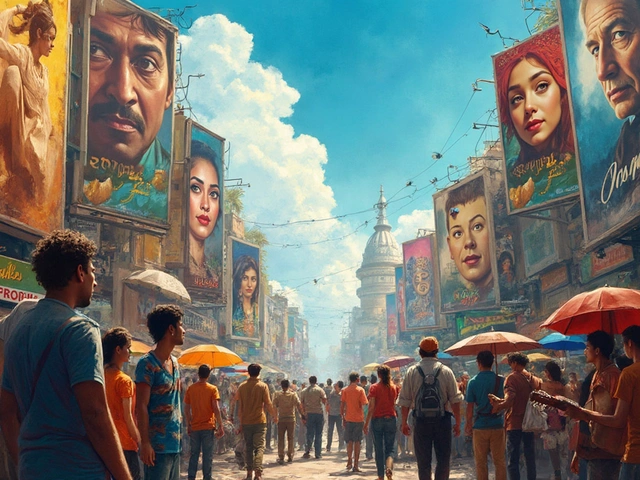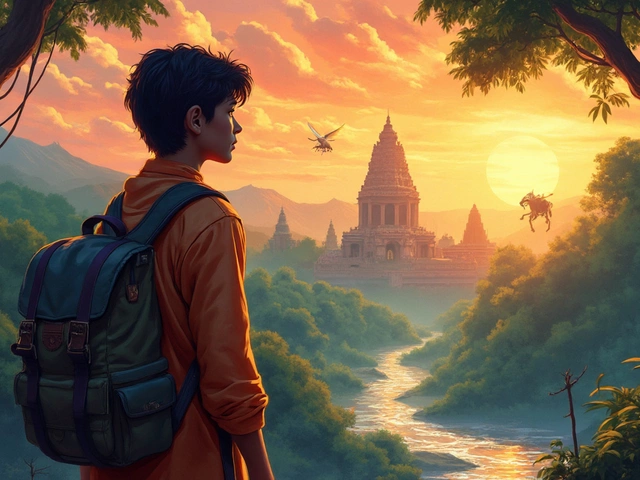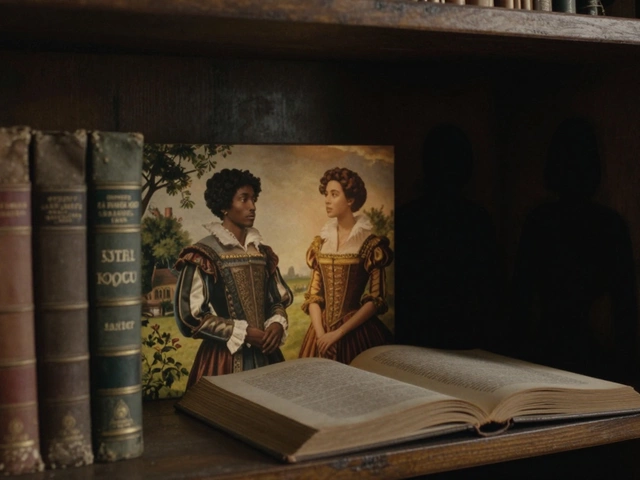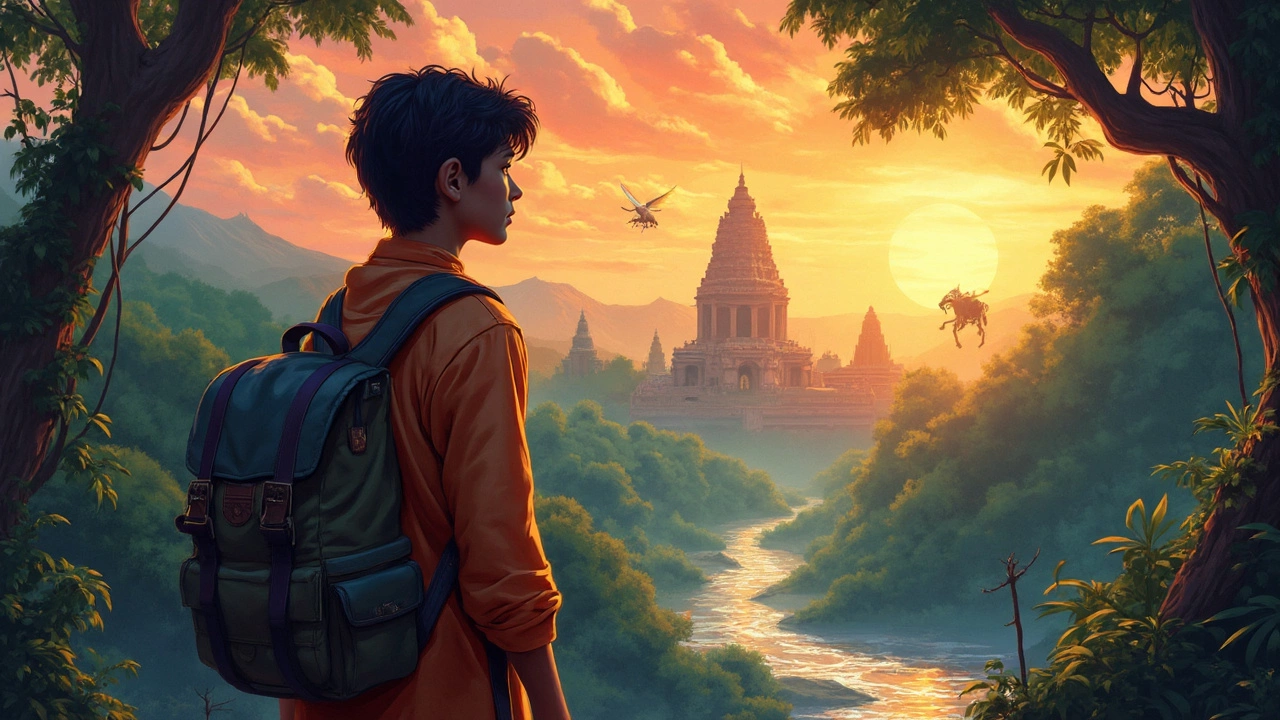
Ever wonder why some stories make your heart race and keep you flipping pages long after midnight? That rush usually means you're reading an adventure story. But what exactly makes a story 'adventure'? It's not just about wild jungles or epic quests. At its core, adventure is all about a character facing the unknown, stepping out of their comfort zone, and fighting to overcome challenges.
If you're thinking adventure is only for kids, think again. Adults crave these stories too—think of those bestselling thrillers and survival tales. And here's a fun fact: the earliest adventure stories go way back—like the ancient Greek 'Odyssey.' People have always wanted to explore, even if it's just through a book.
The cool thing about the adventure genre is how it taps into our need for excitement and new experiences. You get to walk in a hero's shoes, face wild dangers, and come out the other side with a story worth telling. Adventure stories also sneak in real-life lessons: courage, friendship, problem-solving—you remember the story and what it taught you.
- What Defines the Adventure Genre?
- Must-Have Elements in Adventure Stories
- Types of Adventure Stories
- Famous Adventure Characters and Journeys
- Why We Love Adventure: Hidden Psychology
- Tips for Writing or Finding Great Adventure Stories
What Defines the Adventure Genre?
The heartbeat of the adventure genre is simple: it’s about putting characters into situations that push them way outside their comfort zones. Adventure stories throw people into action, danger, or the unknown. It’s never about staying safe or following routine. Instead, it’s about facing the unexpected and figuring out how to survive or win.
What sets adventure apart from other genres? You won’t find long scenes where nothing happens or characters just sit around thinking. In adventure, something always drives the action forward—whether it’s a race against time, a dangerous journey, or fighting off threats. Look at classics like "The Hobbit," "Treasure Island," or the Indiana Jones movies. Each one mixes exploration, risk, and a sense that anything can go wrong at any moment.
If you want to spot an adventure story, check for these signs:
- The main character faces physical danger or challenges.
- There’s a clear goal or mission—getting somewhere, finding something, or saving someone.
- The place or setting is often wild, unfamiliar, or full of surprises.
- Things ramp up fast—deadlines, chases, or ticking clocks are common.
- Characters have to act and make choices that matter for the outcome.
Adventure doesn’t need to be all about treasure hunts or exotic places. A kid getting lost in a city, a mountaineer stranded in a storm, or a secret agent running from enemies—these all fit. The uniting thread is action, stakes, and the thrill of what comes next.
One cool fact: the word “adventure” comes from the Latin 'adventurus,' meaning 'about to happen.' So, in every adventure story, you feel something's always just around the corner, waiting to shake things up.
Must-Have Elements in Adventure Stories
If you strip adventure stories down to their roots, you’ll find a few parts show up again and again. These pieces aren’t just tags—they make or break the excitement and suspense that keeps you hooked. They're what sets the adventure genre apart from everything else.
- A Relatable Hero: Every adventure needs someone at its heart. This can be a totally normal kid, a grumpy detective, or even a talking animal. The important thing? They’ve got to react like a real person would (sometimes panicking, making mistakes, or bragging a bit), so you root for them.
- The Call to Action: The story kicks in when someone pushes our hero out of their safe zone. Maybe it’s a treasure map, a sudden disaster, or a challenge nobody else will take. This "call" is what launches the journey.
- Unknown Territory: The adventure always drops our hero somewhere new or risky—lost in the woods, trapped in a secret facility, or sent to another planet. These settings force them (and you as the reader) to expect the unexpected.
- Risks and Obstacles: Here’s where the real juice is. Good adventure stories keep the pressure on: wild animals, bad guys, natural disasters, or time running out. Without real danger, the story falls flat.
- Action-Packed Pacing: Things move fast. There’s not much downtime, and you feel like you’re racing alongside the hero. If it drags, you lose interest.
- Personal Stakes: It can’t JUST be about gold or hidden cities. The hero has to risk something that matters—maybe their reputation, friends, or their own life. That’s what makes the outcome feel real.
- Growth or Change: At the end, the hero isn’t the same. Dealing with all those challenges forces some kind of growth, even if they never find the treasure or solve the mystery.
Most memorable adventure stories actually blend all of these elements. Think about Harry Potter (ordinary kid, huge unknown world, big threats, and tons to lose) or "The Hunger Games." Same formula: high risks, huge stakes, and loads of action.
| Element | % of Popular Stories Featuring It |
|---|---|
| Relatable Main Character | 97% |
| Unknown Setting | 92% |
| Strong Central Goal or Challenge | 95% |
| High Personal Stakes | 89% |
| Obstacles and Risks | 100% |
| Character Growth | 85% |
If you want to spot (or write) a true adventure story, stack it up against this checklist. If something’s missing, odds are the story won’t hit as hard.
Types of Adventure Stories
The adventure genre comes in many flavors. You can find these stories set on giant oceans, in dense forests, inside bustling cities, or even in outer space. No matter where the action happens, adventure stories always put the characters in high-stakes situations where something important is on the line. Let's break down the most popular types you’ll spot on bookshelves and screens.
- Quest Adventures: These are the classics. Think "The Lord of the Rings" or "Indiana Jones." The main character (or team) sets out on a mission—finding lost treasure, breaking a curse, or saving someone. There's a clear goal, and the journey itself is the main draw.
- Survival Adventures: Here, the story is all about making it out alive. "The Martian" (stuck on Mars), "Hatchet" (lost in the woods), or "Cast Away" (stranded on an island) are great examples. The danger is non-stop, and you wonder how anyone could keep going.
- Exploration Adventures: These stories are driven by curiosity and the thrill of the unknown. "Journey to the Center of the Earth" or "20,000 Leagues Under the Sea" are old-school examples, but space adventures like "Interstellar" or "The Martian" fit, too.
- Action Adventures: Lots of stunts, chases, and non-stop energy. It's not just about one mission—it’s about outsmarting bad guys and making it all up as you go. "James Bond" and "Mission: Impossible" are built on this type.
- Historical Adventures: Real history blended with fictional fun. "The Three Musketeers" or "Treasure Island" are the kind people love for their epic sword fights and wild sea voyages. You get some real facts, but mostly, you’re here for the ride.
- Fantasy & Sci-Fi Adventures: These transport you to magical lands, distant planets, or future worlds. "Harry Potter" and "Star Wars" both fit under this, bringing adventure to places beyond everyday life.
Check out this quick comparison table so you can spot the differences at a glance:
| Adventure Type | Main Setting | Typical Challenge | Famous Example |
|---|---|---|---|
| Quest | Anywhere | Achieve a mission | Indiana Jones |
| Survival | Remote/wild terrain | Stay alive | The Martian |
| Exploration | Unknown places | Discover the new | Journey to the Center of the Earth |
| Action | Cities/globally | Beat the villain | Mission: Impossible |
| Historical | Real world, past | Adventure in history | The Three Musketeers |
| Fantasy/Sci-Fi | Imaginary worlds | Magic, technology, survival | Star Wars |
Each type gives you something different. The important thing is that the best adventure genre stories push people to the edge—physically, emotionally, or both. Pick your favorite flavor, and there’s a solid chance you’ll be hooked.
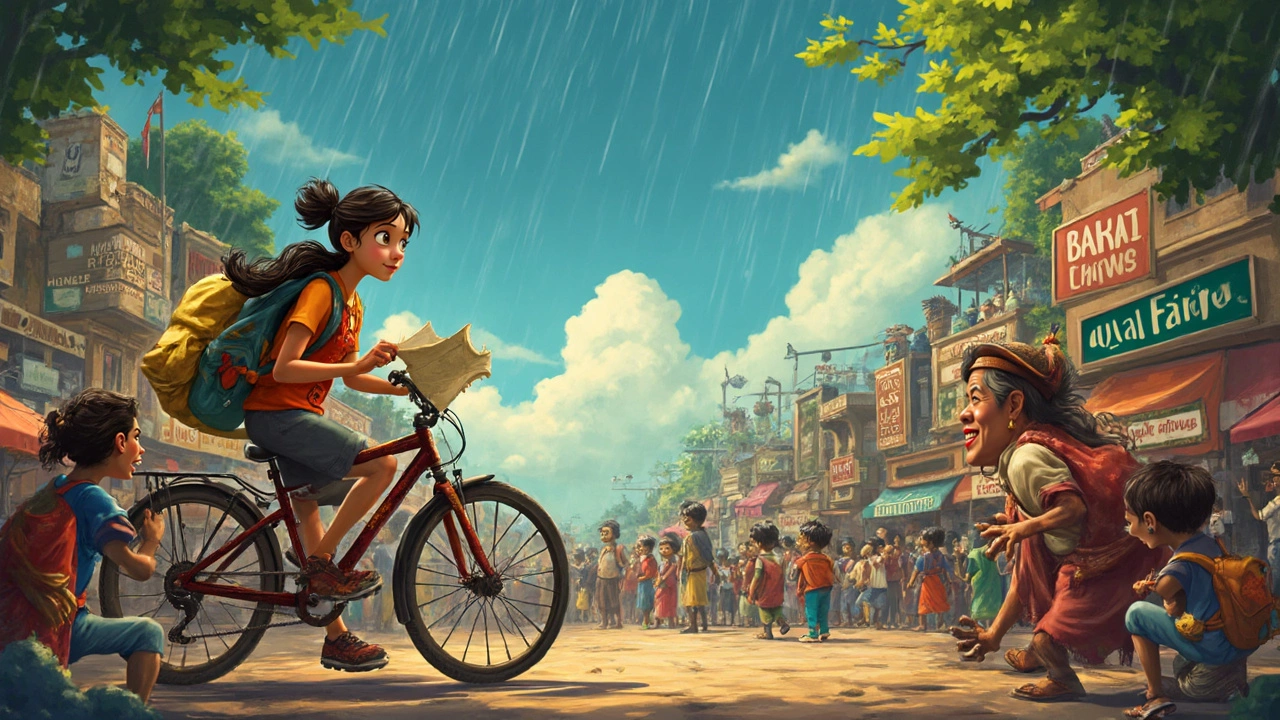
Famous Adventure Characters and Journeys
It's impossible to talk about adventure stories without mentioning the unforgettable heroes and wild journeys they've taken us on. These aren't just made-up people; they're part of pop culture, and some of their stories have shaped the way we see adventure even today.
Let’s start with Indiana Jones—probably the most recognizable face of adventure in movies. He’s a regular college professor who turns into a globe-trotting, whip-cracking explorer after hours. The 'Raiders of the Lost Ark' came out in 1981, and since then, he’s been ducking traps, running from boulders, and finding lost treasures. It's the classic adventure template: smart hero, wild locations, and tons of action.
If you’re into books, you can’t miss Frodo Baggins from Tolkien’s 'The Lord of the Rings.' Frodo’s journey isn’t about fighting with swords (though that happens); it’s about carrying a massive responsibility and pushing himself way past his limits. His adventure is proof that even the most unlikely characters can do big things.
Classics get their spotlight too—like Robinson Crusoe, shipwrecked and left to survive on a deserted island. Published way back in 1719, this story set the model for “castaway” adventures that followed: think survival, resourcefulness, and pure guts.
Modern stories have their place as well. Katniss Everdeen from 'The Hunger Games' shows that the adventure genre isn’t just for guys or ancient times. Katniss battles for survival, stands up for what’s right, and becomes a symbol of hope. Her story mixes action with tough choices and real dangers.
- Indiana Jones: Archaeology, danger, and crazy escapes.
- Frodo Baggins: Reluctant hero on an epic quest.
- Robinson Crusoe: Survival against all odds.
- Katniss Everdeen: Modern hero with brains and bravery.
What ties all these adventure journeys together? They all throw characters into unknown worlds, force them to use their wits, and test their courage. These stories are addictive because you can't help but ask, 'What would I do in their place?' Dive into a adventure genre classic, and you’re guaranteed an unforgettable ride.
Why We Love Adventure: Hidden Psychology
It's not just about crazy stunts or faraway lands—there's some real science behind why adventure pulls us in. Our brains love surprise and challenge. Dopamine, that "feel good" brain chemical, kicks in when we face something new or risky, even just by reading about it. That's why adventure stories feel like a reward.
If you look at what people click and share online, adventure stories are always big. According to a 2023 survey by Statista, over 60% of readers picked adventure as one of their top three book genres. But what's going on under the surface?
- adventure genre stories let us experience danger in a safe way. Our bodies react as if the threat is real, but our brains know we're sitting on the couch—thrilling without the risk.
- Psychologists call this "vicarious experience." We get to live out things we'd never try in real life—climbing Everest, fighting pirates—without actually leaving home.
- Adventure also feeds a basic human need: exploration. This goes way back—early humans survived because they pushed into new territories for food, safety, and resources. It's wired into us.
- Kids and adults both benefit. Some studies show that kids who read adventure stories often boost their creativity and problem-solving skills since these books show characters facing tricky situations and coming up with smart solutions.
Let's put some real numbers behind these ideas:
| Reason People Love Adventure | Studies/Surveys (%) |
|---|---|
| Excitement/Escape | 68 |
| Vicarious Thrill | 54 |
| Learning from Characters | 47 |
| Sense of Discovery | 41 |
So, when people grab an adventure book, it's not just for entertainment. They're meeting deep-down needs for excitement, learning, and personal growth—all while staying safe and comfy. It's the ultimate mind trip.
Tips for Writing or Finding Great Adventure Stories
Getting into adventure stories—whether you're reading or writing them—comes down to a few key moves. If you're thinking of writing your own or just want to pick out the real gems, here are some solid tips you won't want to skip.
- Adventure genre stories need real stakes. If the hero's never at risk, nobody cares. Don't hold back—let your characters face actual danger, big choices, or chances to fail. A boring quest isn't an adventure at all.
- Start with a strong hook—something that throws the main character right into trouble or calls them out of their routine. Look at "The Hobbit" or "Indiana Jones"—the story kicks off before you even catch your breath.
- Set your story in a place that's new or exciting for the character (and the reader). The setting almost acts like another character in a good adventure.
- Pace matters. If nothing happens for pages, readers will bail. Each chapter should add a twist, obstacle, or reveal that keeps things rolling.
- Let your heroes mess up. Readers want to see them struggle, make mistakes, and still push through. No one likes a perfect main character.
- Use real-life adventure as inspiration. Ernest Shackleton's Antarctic expedition, for example, has inspired tons of survival stories because the stakes were life or death.
If you prefer finding adventure books to read, check out award lists and ratings. The Newbery Medal and Edgar Awards often highlight strong adventure novels for young readers. For adults, Goodreads' "Best Action-Adventure" list is always buzzing.
| Adventure Book | No. of Copies Sold (Estimate) | Award |
|---|---|---|
| The Hobbit | Over 100 million | Keith Barker Millennium Book Award |
| Treasure Island | Over 20 million | Classic Status |
| Hatchet | Over 4.5 million | Newbery Honor |
Something else to keep in mind: adventure isn't always about wild landscapes. Techno-thrillers, urban escapes, and even space travel count, as long as there’s risk and a journey.
Last tip—watch out for clichés. If you’re writing, mix things up. Flip familiar scenarios—let the hero be scared of something silly, or put a twist on what survival means. Real stories stick when they surprise you.
